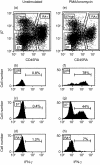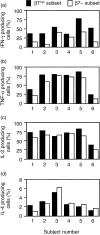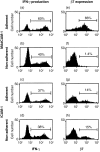Preferential production of interferon-gamma by CD4+ T cells expressing the homing receptor integrin alpha4/beta7
- PMID: 11412302
- PMCID: PMC1783237
- DOI: 10.1046/j.0019-2805.2001.01234.x
Preferential production of interferon-gamma by CD4+ T cells expressing the homing receptor integrin alpha4/beta7
Abstract
Recent studies indicate that T helper type 1 (Th1) and 2 (Th2) lymphocytes differ in their expression of molecules that control T-cell migration, including adhesion molecules and chemokine receptors. We investigated the relationship between cytokine production and expression of the homing receptor integrin alpha4/beta7 on T cells. We began by analysing cytokine production by human CD4+ CD45RA- memory/effector T cells following brief (4 hr) stimulation with phorbol 12-myristate 13-acetate (PMA) and ionomycin. alpha4/ beta7high CD4+ T cells were more likely to produce the Th1 cytokine interferon-gamma (IFN-gamma) than were alpha4/beta7- CD4+ T cells in all six subjects studied. In contrast, production of the Th2 cytokine interleukin-4 (IL-4) was similar on alpha4/ beta7high and alpha4/beta7- CD4+ T cells. In addition, we found that human CD4+ CD45RA- T cells that adhered to the alpha4/beta7 ligand mucosal addressin cell adhesion molecule-1 (MAdCAM-1) had a greater capacity to produce IFN-gamma than did non-adherent cells, suggesting that the association between alpha4/beta7 expression and IFN-gamma production has functional significance. These results suggested that primary activation under Th1-promoting conditions might favour expression of alpha4/beta7. We directly examined this possibility, and found that naïve murine CD4+ T cells activated under Th1-promoting conditions expressed higher levels of alpha4/beta7 compared to cells activated under Th2-promoting conditions. The association between alpha4/beta7 expression and IFN-gamma production by CD4+ T cells may help to determine the cytokine balance when MAdCAM-1 is expressed at sites of inflammation in the intestine or elsewhere.
Figures

 and β7– subsets, as shown. IFN-γ production was then determined for
and β7– subsets, as shown. IFN-γ production was then determined for  , β7– and CD45RA+ CD4+ T cells for the unstimulated (b–d) and stimulated (f–h) samples.
, β7– and CD45RA+ CD4+ T cells for the unstimulated (b–d) and stimulated (f–h) samples.
 and β7– human blood CD4+ CD45RA– T cells from six normal subjects. Production of the cytokines IFN-γ (a), TNF-α (b), IL-2 (c), and IL-4 (d) were measured by intracellular cytokine staining after 4 hr stimulation with PMA and ionomycin. The association between cytokine production and β7 expression on CD4+ CD45RA– T cells was determined using the approach outlined in Fig. 1.
and β7– human blood CD4+ CD45RA– T cells from six normal subjects. Production of the cytokines IFN-γ (a), TNF-α (b), IL-2 (c), and IL-4 (d) were measured by intracellular cytokine staining after 4 hr stimulation with PMA and ionomycin. The association between cytokine production and β7 expression on CD4+ CD45RA– T cells was determined using the approach outlined in Fig. 1.
 and β7– human blood CD8+ CD45RA– T cells from six normal subjects. The experimental protocol and analysis were performed in the same manner as described in Figs 1 and 2, except that a CD8 antibody was used for staining cells (instead of a CD4 antibody). Columns labelled ‘0’ indicate that no cytokine production was detected for these subsets.
and β7– human blood CD8+ CD45RA– T cells from six normal subjects. The experimental protocol and analysis were performed in the same manner as described in Figs 1 and 2, except that a CD8 antibody was used for staining cells (instead of a CD4 antibody). Columns labelled ‘0’ indicate that no cytokine production was detected for these subsets.


Similar articles
-
Pharmacology of AMG 181, a human anti-α4 β7 antibody that specifically alters trafficking of gut-homing T cells.Br J Pharmacol. 2013 May;169(1):51-68. doi: 10.1111/bph.12134. Br J Pharmacol. 2013. PMID: 23425116 Free PMC article.
-
Effect of IL-4, IFN-gamma and IL-12 on cytokine production from human CD45RA and CD45RO CD4 T cell precursors.Int Arch Allergy Immunol. 1998 Dec;117(4):255-62. doi: 10.1159/000024020. Int Arch Allergy Immunol. 1998. PMID: 9876227
-
Up-regulation of VCAM-1 and differential expansion of beta integrin-expressing T lymphocytes are associated with immunity to pulmonary Mycobacterium tuberculosis infection.J Immunol. 2000 May 1;164(9):4853-60. doi: 10.4049/jimmunol.164.9.4853. J Immunol. 2000. PMID: 10779794
-
Role of beta7 integrins in intestinal lymphocyte homing and retention.Curr Mol Med. 2009 Sep;9(7):836-50. doi: 10.2174/156652409789105525. Curr Mol Med. 2009. PMID: 19860663 Free PMC article. Review.
-
Selective differences in the expression of the homing receptors of helper lymphocyte subsets.Clin Immunol Immunopathol. 1998 Nov;89(2):110-6. doi: 10.1006/clin.1998.4589. Clin Immunol Immunopathol. 1998. PMID: 9787112 Review.
Cited by
-
Functional characterization of biodegradable nanoparticles as antigen delivery system.J Exp Clin Cancer Res. 2015 Oct 6;34:114. doi: 10.1186/s13046-015-0231-9. J Exp Clin Cancer Res. 2015. PMID: 26444005 Free PMC article.
-
Preferential HIV infection of CCR6+ Th17 cells is associated with higher levels of virus receptor expression and lack of CCR5 ligands.J Virol. 2013 Oct;87(19):10843-54. doi: 10.1128/JVI.01838-13. Epub 2013 Jul 31. J Virol. 2013. PMID: 23903844 Free PMC article.
-
Commentary: Targeting herpetic keratitis by immunomodulation of IL-27 signaling.Indian J Ophthalmol. 2019 Nov;67(11):1828-1829. doi: 10.4103/ijo.IJO_1364_19. Indian J Ophthalmol. 2019. PMID: 31638042 Free PMC article. No abstract available.
-
Reciprocal and dynamic control of CD8 T cell homing by dendritic cells from skin- and gut-associated lymphoid tissues.J Exp Med. 2005 Jan 17;201(2):303-16. doi: 10.1084/jem.20041645. Epub 2005 Jan 10. J Exp Med. 2005. PMID: 15642741 Free PMC article.
-
Difference in Th1 and Th17 lymphocyte adhesion to endothelium.J Immunol. 2012 Feb 1;188(3):1421-30. doi: 10.4049/jimmunol.1101647. Epub 2012 Jan 4. J Immunol. 2012. PMID: 22219321 Free PMC article.
References
-
- Butcher EC, Picker LJ. Lymphocyte homing and homeostasis. Science. 1996;272:60–6. - PubMed
-
- Butcher EC, Williams M, Youngman K, Rott L, Briskin M. Lymphocyte trafficking and regional immunity. Adv Immunol. 1999;72:209–53. - PubMed
-
- Berlin C, Berg EL, Briskin MJ, et al. α4β7 integrin mediates lymphocyte binding to the mucosal vascular addressin MAdCAM-1. Cell. 1993;74:185–5. - PubMed
-
- Erle DJ, Briskin MJ, Butcher EC, Garcia-Pardo A, Lazarovits AI, Tidswell M. Expression and function of the MAdCAM-1 receptor, integrin α4β7, on human leukocytes. J Immunol. 1994;153:517–28. - PubMed
-
- Streeter PR, Berg EL, Rouse BT, Bargatze RF, Butcher EC. A tissue-specific endothelial cell molecule involved in lymphocyte homing. Nature. 1988;331:41–6. - PubMed
Publication types
MeSH terms
Substances
Grants and funding
LinkOut - more resources
Full Text Sources
Medical
Research Materials

